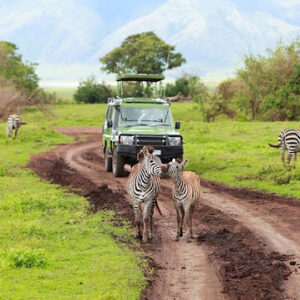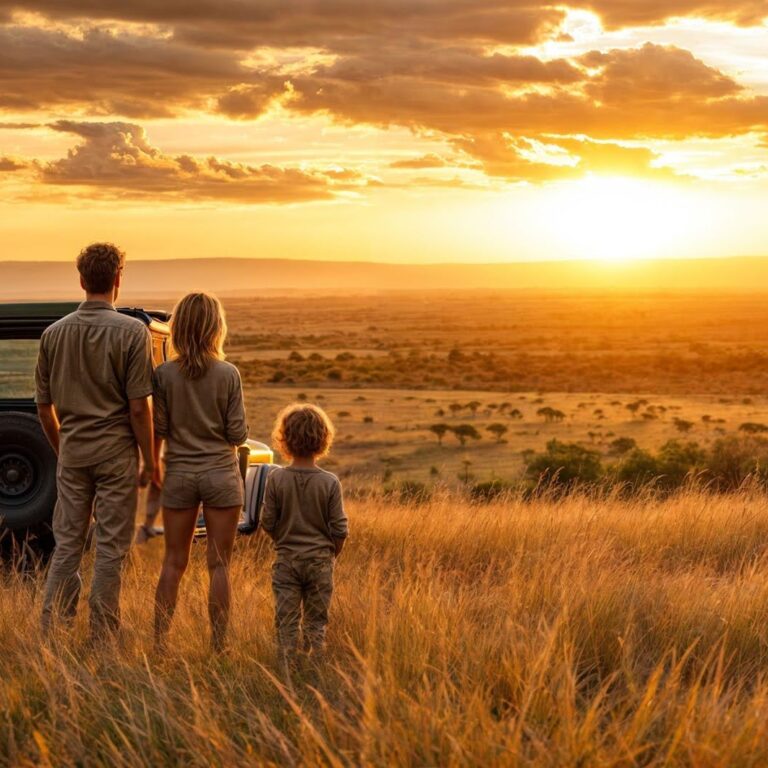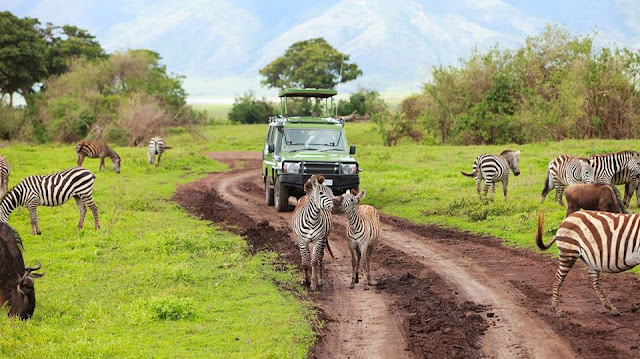Embarking on a safari in Tanzania is a dream for many nature enthusiasts and adventure seekers. The chance to witness the Great Migration, explore the Serengeti, and marvel at the Ngorongoro Crater makes Tanzania a top safari destination. Planning such a trip can seem daunting, but breaking it down into manageable steps can make the process enjoyable and stress-free tips for going on Safari in East Africa.
Planning a safari in Tanzania requires careful preparation to ensure a memorable experience. Start by choosing the best time to visit, typically between June and October, during the dry season when wildlife is easier to spot. Research the major parks, such as Serengeti, Ngorongoro Crater, and Tarangire, each offering unique wildlife experiences.
Decide whether to go on a guided tour or a self-drive safari. Guided tours provide expert knowledge and convenience, while self-drive safaris offer more flexibility but require good knowledge of the terrain. Budgeting is key. Tanzania offers options ranging from luxury lodges to more affordable campsites. Plan your accommodations accordingly.
Also, consider booking in advance, especially during peak seasons, to secure your preferred lodgings and guides. Don’t forget about vaccinations and travel insurance. Lastly, pack appropriately for varying weather conditions and remember to bring binoculars, a camera, and essentials like sunscreen and insect repellent. With these preparations, your Tanzanian safari will be an unforgettable adventure. Here’s a comprehensive guide to planning your Tanzanian safari in 17 easy steps.
Step 1: Choose the Best Time to Visit Tanzania
The first crucial step in planning your safari is deciding when to go. Tanzania’s dry season, from late June to October, is generally considered the best time for wildlife viewing. During this period, animals gather around water sources, making them easier to spot. The Great Migration, where millions of wildebeest and zebras traverse the Serengeti, usually occurs between June and September. If you prefer lush landscapes and fewer crowds, consider visiting during the green season from November to March, although some areas may experience short rains.
Step 2: Decide on Your Tanzania Safari Destinations
Tanzania offers a plethora of national parks and conservation areas, each with unique attractions step by step how to plan your dream safari in Tanzania:
Serengeti National Park: Famous for the Great Migration and a wealth of wildlife.
Ngorongoro Crater: Renowned for its stunning landscapes and high density of animals.
Tarangire National Park: Known for its large elephant herds and iconic baobab trees.
Lake Manyara National Park: Offers diverse ecosystems and tree-climbing lions.
Selous Game Reserve: A less crowded option with rich wildlife and varied landscapes.
Research these destinations to determine which align with your interests and the type of safari experience you desire.
Step 3: Determine Your Tanzania Safari Style
Tanzania caters to various safari styles, each offering a unique experience:
Luxury Safaris: High-end lodges and camps with top-notch amenities.
Mid-Range Safaris: Comfortable lodges and camps that offer good value for money.
Budget Safaris: Basic accommodations and camping options for the cost-conscious traveler.
Private Safaris: Tailored experiences with a personal guide and vehicle.
Private small group safaris: We only offer private, customized, tailor-made small groups for travel agents or individuals planning shared experiences with other travelers who are coming together, often more affordable.
Decide which style suits your preferences and budget to narrow down your options.
Step 4: Set a Tanzania Safari Budget
Establishing a budget is vital for your safari planning. Consider the costs of flights, accommodations, park fees, guide services, and optional activities. Luxury safaris can be expensive, while budget options offer a more economical yet still enriching experience. A well-defined budget helps streamline your choices and prevents overspending.
Step 5: Choose a Reputable Tanzania Safari Operator
Selecting a reliable Foot Slopes Tours and Safaris Tanzania safari tour operator is essential for a successful trip. Look for operators with positive reviews, extensive experience, and knowledgeable guides. Recommendations from friends, travel forums, and websites like TripAdvisor can be invaluable. Ensure the operator is licensed and adheres to responsible tourism practices. How to plan your first safari vacation, especially if you want to organize everything yourself and are planning for the high season, you should start at least one year in advance.
Step 6: Decide How Many Days of Tanzania Safari You Want to Book
The length of your safari will depend on your interests, budget, and available time. Most safaris range from 3 to 10 days. A longer safari allows you to explore multiple parks and increases your chances of witnessing spectacular wildlife events. Discuss your preferences with your safari operator to create a suitable itinerary.
Step 7: Book Flights to Tanzania
Once your safari dates and destinations are set, book your flights to Tanzania. Kilimanjaro International Airport (JRO) and Julius Nyerere International Airport (DAR) in Dar es Salaam are the main entry points. Compare prices, book early for the best deals, and ensure your flights align with your safari schedule.
Step 8: Obtain Necessary Vaccinations and Medications
Consult your doctor or a travel clinic about the required vaccinations and medications for Tanzania. Common recommendations include vaccines for yellow fever, hepatitis A and B, typhoid, and tetanus. Malaria is prevalent in Tanzania, so take prophylactic medication and use insect repellent and mosquito nets during your stay.
Step 9: Secure Travel Insurance
Travel insurance is vital for any safari adventure. Ensure your policy covers medical emergencies, trip cancellations, lost luggage, and other unforeseen events. Check if your safari operator offers any insurance packages or recommendations.
Step 10: Pack Appropriately for Tanzania Safari
Packing wisely is crucial for a comfortable and enjoyable safari one of the ultimate guides to planning a safari in Tanzania. Essentials include:
Lightweight, neutral-colored clothing
A wide-brimmed hat and sunglasses
Comfortable walking shoes
A good-quality camera with extra batteries and memory cards
Binoculars for wildlife viewing
Personal medications and a basic first-aid kit
Travel documents and copies
Sunscreen and insect repellent
Pack light but ensure you have everything you need for a safe and comfortable trip. Don’t dress in flashy clothes – forget colors as red, blue, etc. The blue and the black colors attract the African Tsetse fly, and I believe you don’t want that. Check out the Tanzania Safari Packing List.
Step 11: Prepare Necessary Documents
Ensure all your travel documents are in order. This includes a valid passport (with at least six months’ validity), a Tanzanian visa (which can be obtained online or on arrival), travel insurance details, flight tickets, and a copy of your safari itinerary. Keep digital and physical copies of these documents for easy access.
Step 12: Plan for Currency and Payments
The Tanzanian shilling (TZS) is the local currency. While credit cards are accepted at most lodges and hotels, it’s advisable to carry some cash for tips, small purchases, and local markets. ATMs are available in major cities, but not in remote safari areas. Inform your bank of your travel plans to avoid issues with card transactions.
Step 13: Consider Optional Tanzania Safari Activities
Enhance your safari experience by including optional activities such as:
Hot Air Balloon Safaris: Soar above the Serengeti for a unique perspective.
Walking Safaris: Explore the bush on foot with an armed guide.
Cultural Tours: Visit Maasai villages to learn about their traditions and lifestyle.
Bird Watching: Tanzania is a haven for bird enthusiasts with over 1,000 species.
Beach Extensions: Relax on the pristine beaches of Zanzibar after your safari.
Discuss these options with your safari operator to incorporate them into your itinerary.
Step 14: Stay Informed About Safety and Health
Stay updated on travel advisories and health guidelines for Tanzania. Follow basic safety precautions, such as not venturing into unknown areas alone and safeguarding your belongings. Drink bottled or purified water and practice good hygiene to avoid food and waterborne illnesses.
Step 15: Choose Right Tanzania Safari Accommodations
Tanzania offers a wide range of accommodations, from luxury lodges and tented camps to budget-friendly campsites. When choosing your accommodation, consider factors such as location, amenities, and proximity to wildlife viewing areas. Booking well in advance is advisable, especially during peak seasons.
Step 16: Checking The Booking Terms, Cancellation Policy, and Booking the Tour!
Before finalizing your safari booking, carefully review the terms and conditions, including cancellation policies. Understand what is included in your package and any additional costs you may incur. Once you are satisfied with the details, confirm your booking and make the necessary payments.
Step 17: Choosing Between Tanzania Private and Group Safari
Decide whether a private or group safari suits your preferences. Private safaris offer personalized experiences with more flexibility in your itinerary and activities. Private small-group safaris are often more cost-effective and provide opportunities to meet other travelers. Weigh the pros and cons of each option to make an informed choice.
FAQs: How to Plan a Safari in Tanzania
Discover essential tips for planning a safari in Tanzania with our comprehensive FAQs. Learn about the best time to visit, costs, visas, packing lists, safety, vaccinations, and more. Whether you’re a first-time traveler or an experienced adventurer, our guide provides all the information you need for an unforgettable safari experience in Tanzania. Explore the wonders of the Serengeti, Ngorongoro Crater, and beyond with confidence.
What is the best time of year to go on safari in Tanzania?
The best time to visit is during the dry season from June to October, especially for the Great Migration in the Serengeti. For fewer crowds, consider the shoulder seasons in April-May and November-December.
How much does a safari in Tanzania cost?
Costs vary widely based on the length of stay, type of accommodation, and safari style. Budget safaris can start around $390 – 550 per day, while luxury safaris can exceed $1000 per day.
Do I need a visa for Tanzania?
Yes, most travelers need a visa for Tanzania, which can be obtained online or upon arrival at the airport.
What should I pack for a safari in Tanzania?
Pack light, breathable clothing, comfortable footwear, a hat, sunglasses, sunscreen, insect repellent, binoculars, and a camera.
Is it safe to go on safari in Tanzania?
Yes, safaris in Tanzania are generally safe. Follow the advice of your guide, adhere to park rules, and take standard health precautions.
What vaccinations do I need for Tanzania?
Recommended vaccinations include yellow fever, hepatitis A, typhoid, and routine vaccines. Consult with a healthcare provider for the latest advice and malaria prophylaxis.
Can I combine a safari with a beach holiday in Tanzania?
Absolutely. Many travelers combine their safari with a beach stay in Zanzibar, offering a perfect blend of adventure and relaxation.
How long should I plan my safari?
Safaris can range from 3 days to 2 weeks. A 7-10 day safari allows for a comprehensive experience across multiple parks.
What type of accommodation is available on a Tanzanian safari?
Options range from luxury lodges and tented camps to mid-range lodges and budget campsites, catering to various preferences and budgets.
Do I need travel insurance for a safari in Tanzania?
Yes, travel insurance is essential. Ensure it covers medical emergencies, trip cancellations, and safari activities.
Is it cheaper to book a safari in Tanzania?
However, the in-country experience doesn’t change as they will book the services of a local guide. So if you are a budget-conscious traveller looking to go on a cheap safari, or at least a better value safari, then one of the best ways to lower the price is to book directly with the guide. This has multiple benefits.
How to organize a safari in Tanzania?
Learn how to organize a safari in Tanzania with our comprehensive guide. Discover the best time to visit, choose the perfect destinations, plan your budget, and select a reputable safari operator. Prepare for an unforgettable adventure by packing appropriately and securing necessary travel documents. Dive into essential tips and FAQs to ensure a seamless and memorable safari experience in Tanzania’s stunning national parks.
Conclusion: How to Plan a Safari in Tanzania
Planning a safari in Tanzania is an exciting journey in itself. By following these 15 easy steps, you can ensure a smooth and enjoyable experience, filled with unforgettable wildlife encounters and stunning landscapes. From choosing the best time to visit to selecting the right accommodations, each step plays a vital role in crafting your dream safari. Embrace the adventure, and get ready for a once-in-a-lifetime experience in the heart of Africa.








